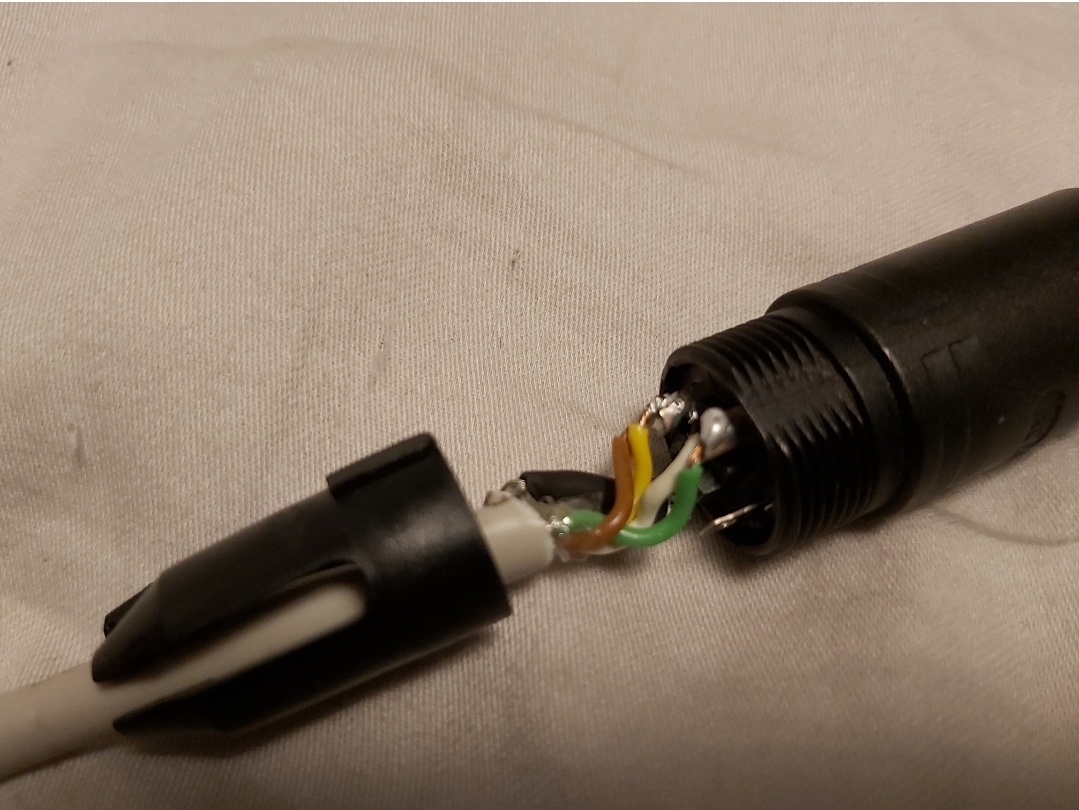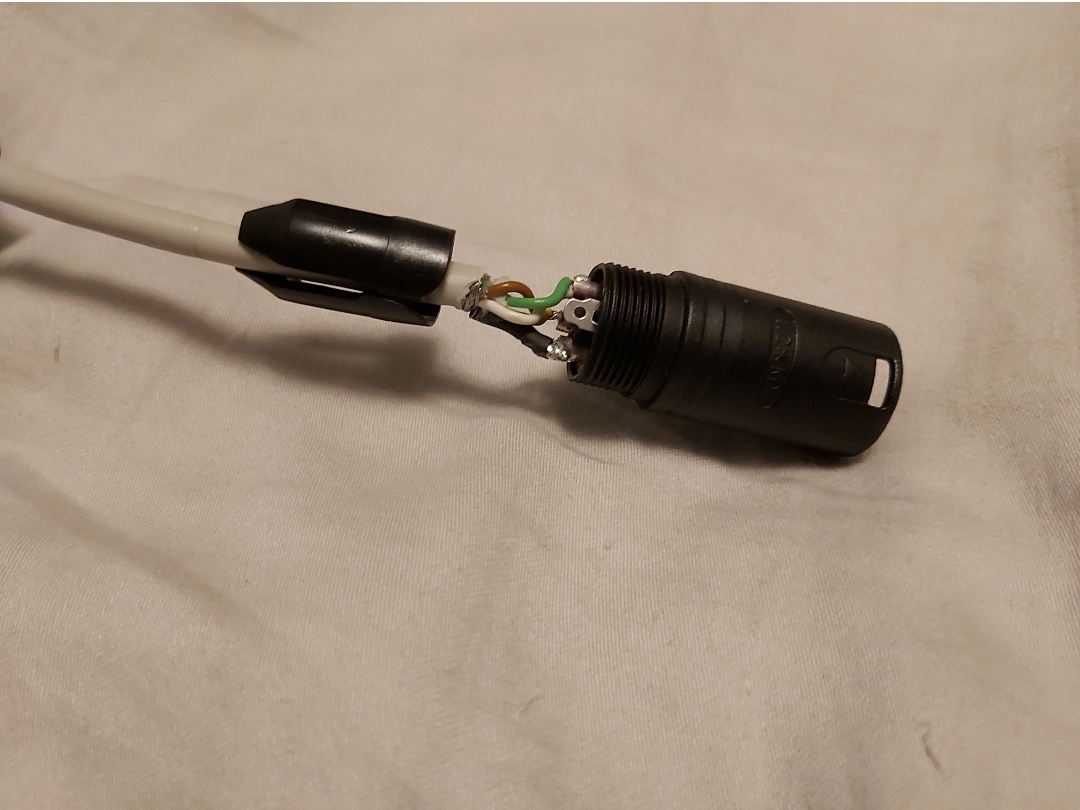Star quad cable is a type of balanced audio cable that specializes in reducing electromagnetic interference. Quad cable is better at rejecting external noise than an equivalent single pair cable. Star-quad cable is a four-conductor cable that has a special quadrupole geometry which provides magnetic immunity when used in a balanced line. Four conductors are used to carry the two legs of the balanced line. Star-quad cable typically provides a 10 dB to 30 dB reduction in magnetically-induced interference compared to standard two‑core mic cables. The up side is better rejection of very close‑source electromagnetically induced interference — the kind of interference that might come from laying a mic cable alongside noisy mains cable. Starquad cables are very good at rejecting very close sources of EM interference — such as when laying mic cables in a cable duct with lighting cables — but are essentially no better than standard balanced cables when the interference source is more than a few feet away.
There are three types of interference that can affect signals in cable: electrostatic, radio frequency, and magnetic interference. Of these, the first two can be minimized effectively using shielding. An overall shield only helps prevent RFI (radio frequency interference). It won’t do a thing for lower frequency noise, or crosstalk, which is where a well twisted pair or quad will prove its worth. Unshielded CAT 5 cable is actually used to carry audio in many broadcast facilities.
The third type, however, requires a different approach as magnetic fields can pass quite easily straight through shielding. The star-quad configuration was invented for use in telephone cables back in the ’30s, and was adopted in the TV world in the ’60s and ’70s. It is widely used today, particularly where there is a likelihood of having to lay mic cables alongside strong sources of interference.
The magnetic immunity of star quad cable is a function of the accuracy of the star-quad geometry, the accuracy of the impedance balancing, and the common-mode rejection ratio of the balanced receiver. All four conductors must be an equal distance from a common point (usually the center of a cable). The four conductors are arranged in a four-pointed star (forming a square). Opposite points of the star are connected together at each end of the cable to form each leg of the balanced circuit. All points of the star must lie at equal distances from the center of the star. In order to maximize noise rejection, Star Quad must be properly wired to the XLR-3 connector (or terminal block).
To a magnetic field, both legs of the balanced circuit appear to be in the exact center of the star. This means that both legs of the balanced circuit will receive exactly the same interference from the magnetic field and a common-mode interference signal will be produced. This common-mode interference signal will be rejected by the balanced receiver. The 4-conductor Star Quad arrangement, cancels electromagnetically induced noise from SCR dimmer packs, fluorescent lighting ballasts and AC power transformers.
So, is it worth paying more for star quad cable? It depends on your usage and how important interference reduction is for you. If the chance of external noise is low, quad cable may very well be “over kill”. But many people prefer to play it safe and use quad cable anyway, just in case they run into a situation where that noise could be a problem. With the portable situations that most of us deal with, external noise is a variable that we have no control over, and quad cable becomes an “insurance” policy. Star quad cables are clearly beneficial for certain needs, but they come at a cost. They are a popular choice in professional audio settings where interference can be an issue, but for simpler settings, they may be a “nice to have” but unnecessary luxury.
The main disadvantage of star quad compared to normal shielded twisted pair microphone cable is higher price and the increased capacitance. Obviously, with four wires in the cable, the core‑core and core‑screen capacitance will be much higher than in a more conventional two‑core cable, and that’s the down side because it can result in a greater HF loss in very long cable runs — although it really won’t be a problem over 10 metres, or even 50. For microphone or line level signals, capacitance of the cable is by far the dominant parameter affecting audio performance. High capacitance will limit frequency response at the high end (treble). The downside is that quad cable has roughly twice the capacitance of equivalent single pair cable. That means you can only run half the distance before the top end starts to roll off, but that distance will still be several hundred feet, even under worse case conditions. The extra capacitance can become an issue in very long cable runs or if you are trying to force AES3 digital signals down the cable!
Sources:
https://en.wikipedia.org/wiki/Star_quad_cable
https://www.soundonsound.com/sound-advice/q-whats-special-about-star-quad-cable
https://www.head-fi.org/threads/suitability-of-starquad-balanced-cables-with-powered-studio-monitors.686298/
http://www.canare.com/ProductItemDisplay.aspx?productItemID=53
https://www.datapro.net/techinfo/star_quad_xlr.html
https://forums.prosoundweb.com/index.php?topic=114366.0
https://jwsoundgroup.net/index.php?/topic/7587-diy-xlr-cables/&page=2
https://www.canare.co.jp/en/products/cables/index.php?tid=4_002
https://www.diyaudio.com/community/threads/canare-star-quad-rca-construciton-methods.259553/
https://www.hifivision.com/threads/diy-star-quad-cable.61455/
https://www.audiocircle.com/index.php?topic=156793.0
https://www.soundonsound.com/forum/viewtopic.php?f=15&t=58458#p525587
https://www.takefiveaudio.com/contents/23-belden83754pc
https://audiointerfacing.com/star-quad-cable/
https://www.soundonsound.com/sound-advice/q-whats-special-about-star-quad-cable
https://benchmarkmedia.com/blogs/application_notes/116637511-the-importance-of-star-quad-microphone-cable
https://www.showmecables.com/belden-1172a-star-quad-low-impedance-microphone-cable-4-conductor
https://www.bhphotovideo.com/c/product/1718524-REG/belden_1192a_1000_bl_1192a_star_quad_low.html
https://www.prysmiangroup.com/en/en_aerospace_wires-and-cables-for-aviation-applications_copper-data-transmission-cables_quad-ethernet-cables_F4704-6.html


7 Comments
Tomi Engdahl says:
From https://www.facebook.com/groups/avdisasters/permalink/5448454255283041/
I Had AI write a song about XLR Cables.
Behold.
In the studio, in the booth
XLR cables carry the truth
Connecting microphones, to the mix
Sending signals, in a flash
Chorus:
XLR cables, XLR cables
The heartbeat of the sound
XLR cables, XLR cables
Without them, we’d be lost and found
Verse 2:
Balanced and sturdy, they hold the line
XLR cables, they work just fine
No matter the length, no matter the task
XLR cables, they never ask
Chorus:
XLR cables, XLR cables
The heartbeat of the sound
XLR cables, XLR cables
Without them, we’d be lost and found
Bridge:
From the stage, to the board
XLR cables carry the load
In the studio, on the road
XLR cables, they carry the show
Chorus:
XLR cables, XLR cables
The heartbeat of the sound
XLR cables, XLR cables
Without them, we’d be lost and found.
Tomi Engdahl says:
https://mogamicable.com/category/bulk/microphone/quad/
https://mogamicable.com/category/bulk/microphone/high_performance/
Tomi Engdahl says:
Balanced Cable Hum Article
http://www.williamsonic.com/StarQuad/index.html
This is the online supplement to my article “Balanced Cable Hum: Cause and Cure”, appearing in the May 2009 issue of audioXpress magazine. It turns out that a simple wall outlet adapter can inject a signal that is 20 dB or more above the noise floor. After reviewing the theory of magnetic induction, I identify several possible solutions. The most attractive solution is the star-quad configuration which is now becoming available. However, the XLR connectors on the end of every mic cable are efficient hum antennas, no matter how good the cable itself is. I therefore call for a new standard for microphone connectors, and list the requirements for such a connector in the article
Tomi Engdahl says:
Deping on the environment even the worst XLR will test extremely close or exactly the same as an expensive one. Now length is a factor. The lesser the quality the more reduction in signal straight witch might make you have to turn up your input gain more than normal raising your noise floor. But it really comes down to pin 1 shield. A lesser quality cable will have a lousy shield wire that will make it more susceptible to EM interference. Phasing issues only come by if the cable was made bad and/or not tested or improperly wired pin 2 and 3 are swapped on just one side.
I think you would be hard to find and or hear the difference between cheap vs expensive unless you setup a noisy situation. Like take a power strip and plug in some 9v and 12v adapters and lay the cables near and on them and see witch one rejects noise better. But a lot comes down to build quality and longevity.
But that’s just my opinion
Tomi Engdahl says:
For the quality how well a XLR cable can avoid external noise is to wire the cable between a silent balanced audio source and one balanced input. Then bring noise sources near cables, listen and measure amount of noise that gets into cable. You need electrical field type noise and magnetic field type noise sources. Then you can do comparison.
Tomi Engdahl says:
Keep them away from AC power, and if they have to go to the same place, cross in a + and keep a foot or more between the power and audio on the run to the destination. Electromagnetic energy transfers. Simple theory really, like a transformer isolated snake or DI box with a ground lift. All the power in my studio walls was run near the ground and audio up high.
Tomi Engdahl says:
Cost has more to do with durability of the cable than if it’s better or worse at rejecting external noise.
Gold pins are pretty worthless in anything other than an ultra picky reference recording. Don’t waste your money.
A balanced cable has 3 conductors.
Hot (in phase) usually pin 2 on an XLR
Cold (reverse phase) usually pin 3 on an XLR
Screen (outer braid, grounded) pin 1 on an XLR
The grounded screen (P1) goes a long way to stop radiated electrical noise getting in to the cables underneath.
However, by having TWO wires carrying the signal, but in opposite phase (i.e. 180° apart) any noise that does get through is picked up by both cables equally and is in the SAME PHASE.
When the signal reaches the input…a mixing desk for instance…. Any noise that is present on BOTH wires in the same phase gets cancelled out by the electronics to leave a nice clean, interference free signal.
Cool, huh ?
This is particularly useful with microphones, as their signal voltage is extremely low.
It’s much less of a problem with interconnects between other gear, as the signal levels are much larger, but balanced cabling is retained, as it’s excellent practice to keep noise very low and costs no more to do.
Have a dig online for balanced and unbalanced cabling, there’s lots of good teachers far better than me that can explain all the ins and outs of why we do this.
Most pro touring companies use standard Van Damme cabling and Neutrik connectors.
If these are assembled with care and then coiled correctly after every use, you’ll easily get 10 years service out of a touring mic cable.
……..And if you want to introduce a test noise to a cable, wrap it around your cellphone a few times and get someone to call you.